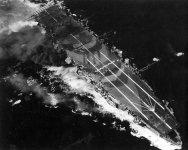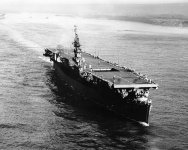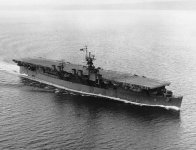Thanks Folks.
I have three areas of interest in the need of light aircraft carriers.
The Battle of Philippines Seas
The Battle of Leyte Gulf
The Pounding of Formosa
Actually there are 4 areas, also the Battle of Bismarck Sea
In the Pacific theater, CVEs provided air support of ground troops in the Battle of Leyte Gulf. They lacked the speed and weapons to counter enemy fleets, relying on the protection of a Fast Carrier Task Force. However, at the Battle off Samar, one U.S. task force of escort carriers and destroyers managed to successfully defend itself against a much larger Japanese force of battleships and cruisers. The Japanese met a furious defense of carrier aircraft, screening destroyers, and destroyer escorts.
Of the 151 aircraft carriers built in the U.S. during World War II, 122 were escort carriers, though no examples survive. The Casablanca class was the most numerous class of aircraft carrier, with 50 launched. Second was the Bogue class, with 45 launched.
Battle off Samar
Main article: Battle off Samar
USS Gambier Bay, burning from earlier gunfire damage, is bracketed by a salvo from a Japanese heavy cruiser (faintly visible in the background, center-right) shortly before sinking during the Battle off Samar.
A battle in which escort carriers played a major role was the Battle off Samar in the Philippines on 25 October 1944. The Japanese lured Admiral William Halsey, Jr. into chasing a decoy fleet with his powerful 3rd Fleet. This left about 450 aircraft from 16 small and slow escort carriers in three task units ("Taffies"), armed primarily to bomb ground forces, and their protective screen of destroyers and slower destroyer escorts to protect undefended troop and supply ships in Leyte Gulf. No Japanese threat was believed to be in the area, but a force of four battleships, including the formidable Yamato,[15] eight cruisers, and 11 destroyers, appeared, sailing towards Leyte Gulf. Only the Taffies were in the way of the Japanese attack.
The slow carriers could not outrun 30-knot (35 mph; 56 km/h) cruisers. They launched their aircraft and maneuvered to avoid shellfire, helped by smoke screens, for over an hour. "Taffy 3" bore the brunt of the fight. The Taffy ships took dozens of hits, mostly from armor-piercing rounds that passed right through their thin, unarmored hulls without exploding. USS Gambier Bay, sunk in this action, was the only U.S. carrier lost to enemy surface gunfire in the war; the Japanese concentration of fire on this one carrier assisted the escape of the others. The carriers' only substantial armament—aside from their aircraft—was a single 5-inch (127 mm) dual-purpose gun mounted on the stern, but the pursuing Japanese cruisers closed to within range of these guns. One of the guns damaged the burning Japanese heavy cruiser Chōkai, and a subsequent bomb dropped by an aircraft hit the cruiser's forward machinery room, leaving her dead in the water. A kamikaze attack sank USS St Lo; kamikaze aircraft attacking other ships were shot down. Ultimately the superior Japanese surface force withdrew, believing they were confronted by a stronger force than was the case. Most of the damage to the Japanese fleet was inflicted by torpedoes fired by destroyers, and bombs from the carriers' aircraft.
The U.S. Navy lost a similar number of ships and more men than in the battles of the Coral Sea and Midway combined (though major fleet carriers were lost in the other battles).
Type of Light and Escort Carriers
Japan
Taiyo class
Taiyo
Unyō
Chuyo
Kaiyo
Shinyo
Shimane Maru class escort carrier
Escort carriers and similar aviation vessels operated by the Japanese Imperial Army:
Yamashio Maru
Akitsu Maru
Nigitsu Maru
Kumano Maru
US Navy
2 (1) Long Island class (Jun 1941 — Nov 1941, Type C3 ship conversion)
45 (11) Bogue class (Jun 1942 — Jun 1943, Type C3 conversion)
4 (4) Sangamon class (Aug 1942 — Sep 1942, T3 tanker conversion)
4 (1) Charger class (Mar 1942 — Jul 1942, Type C3 conversion)
50 (50) Casablanca class (Jul 1943 — Jul 1944)
19 (19) Commencement Bay class (Nov 1944 — Feb 1946
Probably Casablanca Class would be best for the battles I am interested in.
These are just examples, probably best to be set up the carriers as generic rather than a specific ship.







